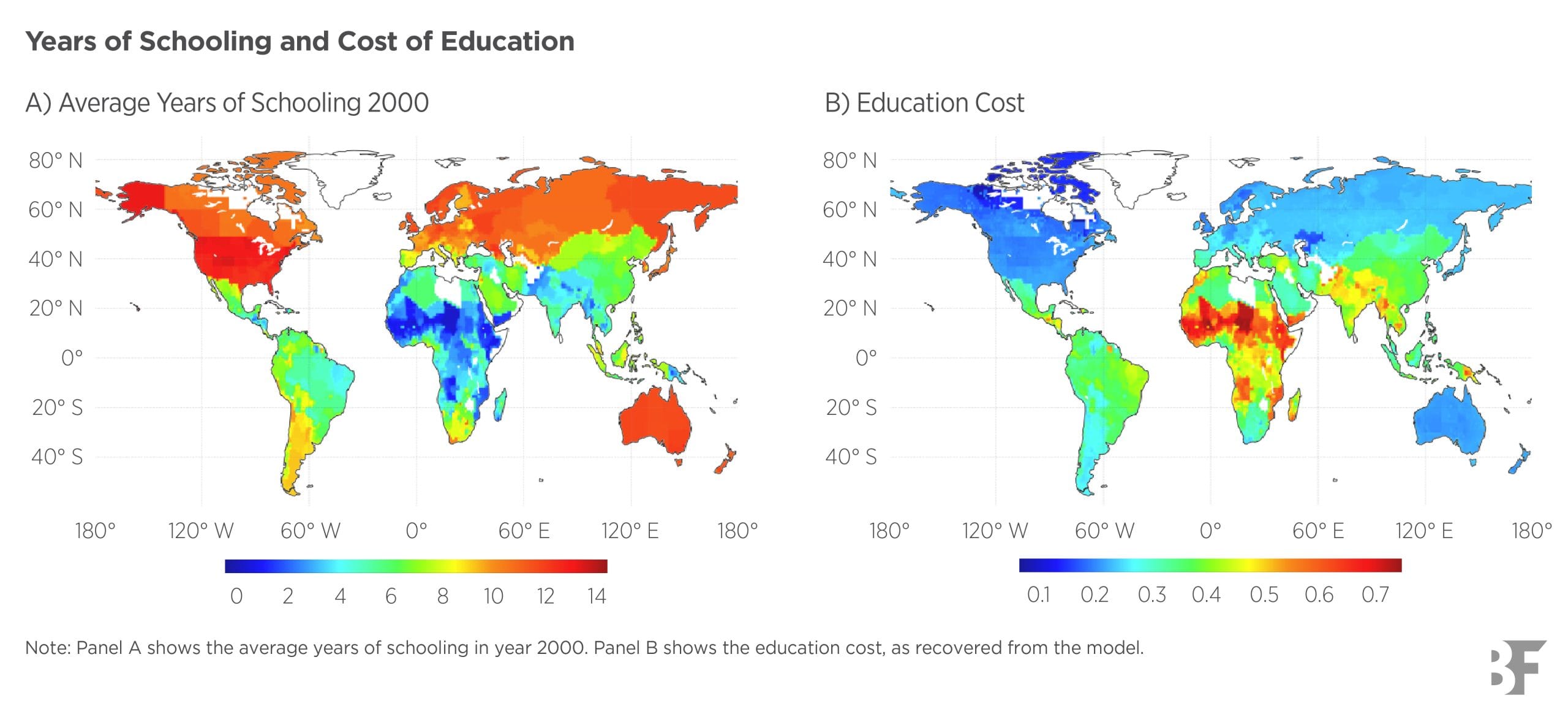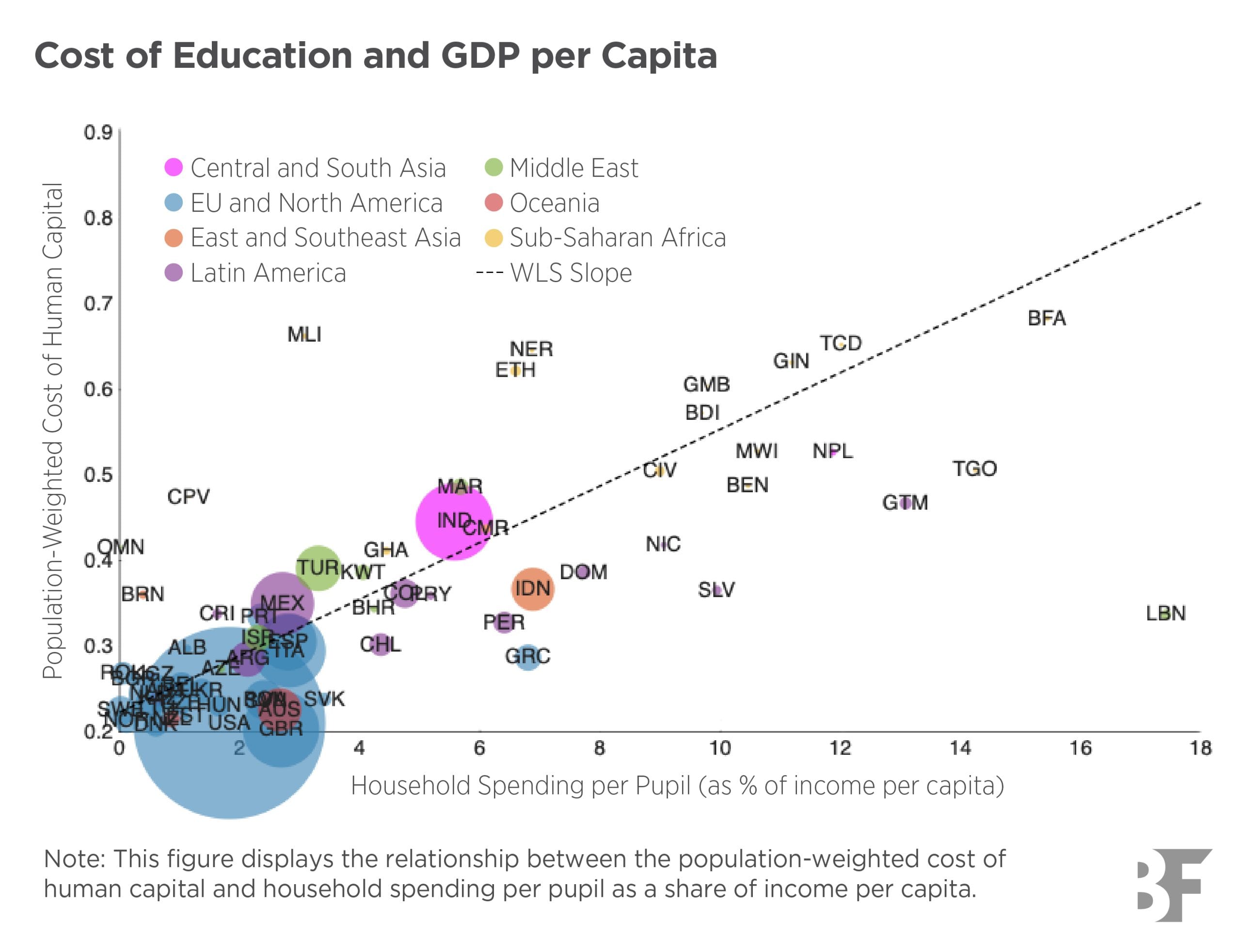Human capital: the collective skills, knowledge, and abilities of individuals that can be used to create economic value , as measured by levels of school-based education, is unevenly distributed across space. In 2000, people in the Netherlands had an average of 10.8 years of schooling, compared to 2.5 years in the Central African Republic. Comparing inhabitants of the most and least educated corners of the globe—specifically, 1° × 1° grid cells at the 90th and the 10th percentiles of educational attainment—this range goes from 11.8 to 3.4 years.
What drives these large differences in human capital across space? The authors examine how two factors shape the geography of development, both today and in the future. First, the cost of acquiring human capital varies widely across locations—in some places, access to education is relatively expensive or difficult, limiting the supply of human capital. Second, the productivity of human capital differs across locations—where human capital generates higher returns, demand for it will be greater. These forces interact with migration, trade, and innovation to determine how human capital evolves across the globe over time.

To address this question, the authors develop a dynamic spatial model of the world economy at a 1° × 1° resolution. In the model, individuals choose where to live and how much human capital to acquire, taking into account that both moving between locations and upgrading human capital are costly, and these costs vary across space. Firms in each location produce differentiated goods using labor, human capital, and land, with trade between locations subject to transport costs.
The model incorporates two key productivity forces. First, a location’s overall productivity benefits from agglomeration economies: the productivity benefits that arise when economic activity concentrates in a particular location, as firms and workers gain advantages from being near one another —as population density increases, so does productivity. Second, locations accumulate human-capital-augmenting technology over time through two channels: local innovation (which depends on the local stock of human capital) and diffusion from other locations. This creates dynamic feedback loops where human capital today boosts innovation tomorrow, attracting more people and generating further innovation.
The authors quantify the model using data on population, income, and schooling from 2000. They identify location-specific costs of acquiring human capital by matching the model to observed changes in schooling levels between 2000 and subsequent years. They then simulate the model forward for 200 years to project how human capital and economic development evolve across space.

They find the following:
- The model predicts strong persistence in the geography of development. Over the span of two centuries, today’s developed regions, such as coastal Australia, Western Europe, Japan, and the United States, remain the most developed 200 years from now. The same persistence holds for population density, as locations that are dense today continue to be dense two centuries from now.
- Even after 200 years, the world economy remains far from reaching a steady state where all regions grow at the same rate. This finding stands in sharp contrast to spatial models that ignore human capital, which instead predict that poor but densely populated areas will eventually catch up to wealthier regions through agglomeration effects alone.
- Low education costs drive persistent advantages in developed regions. Because highly developed regions tend to have low education costs, their human capital levels tend to be high, both in the short and the long run. This advantage is magnified by dynamic feedback loops over the transition path. Current levels of human capital improve future productivity, because human capital is an input in the growth of human-capital-augmenting productivity.
- The model reveals a strong negative correlation between education costs and local economic fundamentals, as places with better amenities, higher productivity, and more favorable conditions for development also tend to have cheaper access to education. As a result, the low cost of acquiring human capital in the developed world keeps these regions ahead, generating the persistence the model projects.
- Reducing education costs by the same percentage across poor regions generates local gains but may cause global losses. The authors examine counterfactual policies that lower the cost of human capital acquisition while maintaining the relative differences between locations within a region. Whether implemented in sub-Saharan Africa, Latin America, or Central and South Asia, the local economy benefits: human capital levels rise, both in the short and the long run. This enhances innovation in human-capital-augmenting productivity, generating positive dynamic effects.
- Higher local welfare retains a larger share of the global population in the target region, further reinforcing productivity through agglomeration economies. However, the effects on global welfare differ markedly by region. When the policy is implemented in a low-income region, like sub-Saharan Africa and Central and South Asia, the local increase in population comes at the expense of regions with better economic fundamentals, reducing global agglomeration and innovation. In contrast, when implemented in a middle-income region like Latin America, the population reallocation comes partly from regions with worse fundamentals, improving outcomes globally.
- Equalizing educational costs across space may lead to unintended consequences. As an alternative policy, the authors consider setting the cost of education to the same level across all grid cells within a region, such as sub-Saharan Africa—eliminating the variation in education costs between locations. Because schooling costs are higher in less developed areas within the region, equalizing costs lowers them more dramatically in those areas.
- This creates incentives for population to migrate toward locations with weaker economic fundamentals. As a result, an increasingly larger share of the region’s population resides in less productive locations, which hurts overall innovation and weakens agglomeration economies through greater geographic dispersion. These negative effects may partly or even fully offset the positive impact of cheaper access to human capital.
These findings suggest that effective development policies must account for spatial frictions, agglomeration effects, and the dynamic relationship between human capital and productivity across space. When evaluating education policies, policymakers must consider not only local benefits but also how these policies reshape the global distribution of population and economic activity. Policies that retain population in regions with weak economic fundamentals may generate local gains while producing global losses. Moreover, within-region heterogeneity matters: equalizing access to education across locations with varying economic potential can trigger population movements that undermine the policy’s intended benefits.












